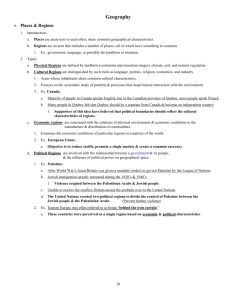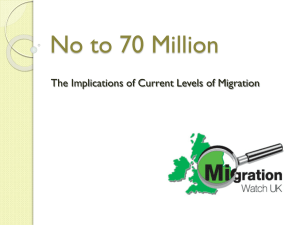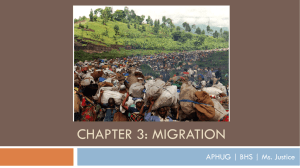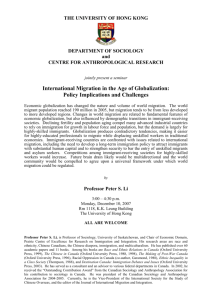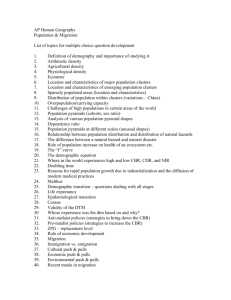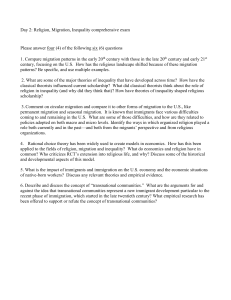Transition from a live-in caregiver to a permanent
advertisement
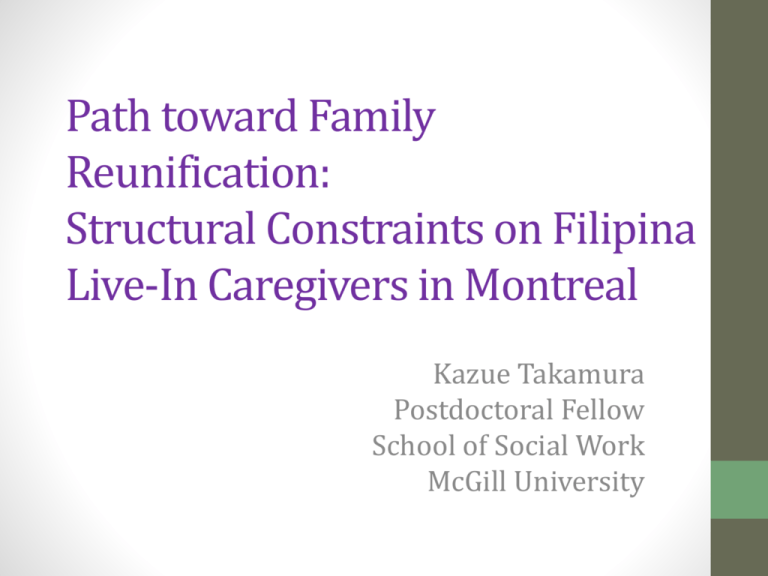
Path toward Family Reunification: Structural Constraints on Filipina Live-In Caregivers in Montreal Kazue Takamura Postdoctoral Fellow School of Social Work McGill University Contents of the presentation Objectives of the study and literature review Problems with the literature The argument: a long-term, structural perspective Analytical framework: types of constraints Why mothers’ migration matters Background Female labor migration from the Philippines Live-In Caregiver Program Structural Constraints on the path toward family reunification and its long term impact on social mobility Conclusion Aim of the study - To analyze the structural constraints on the migration trajectory of female migrants and families in a long-term perspective - The path toward family reunification of Filipina live-in caregivers - Canada’s Live-In Caregiver Program: a unique and crucial pathway to family reunification because of the opportunity to gain residency Problem with the literature on female labor migration Literature is divided into Separation and Settlement Experience of separation (during the labor migration) • Impact of female migration on families: emotional ties, conjugal relations, left-behind children, transnational mothering (Ho 1999; Schmalzbauer 2004; Asis et al. 2004; Scalabrini Migration Center 2004; Parrenas 2005; Yeoh and Lam2007; Dreby 2007, 2010) Experience of settlement (after reunification) • Psychological implication of family separation among immigrant youth (Smith et al. 2004; Rousseau et al. 2009; Suarez-Orozco et al. 2002, 2011) • Intergenerational struggles after the reunification, educational adaptation of newly-arrived children (Cohen 2000; Allen 2004; Pratt 2004, 2009; Caro 2008; Foner 2009; Menjivar and Abrego 2009; Pineda 2010; Corak 2011) • Economic Integration, labor participation (Kelly 2006, 2010; Castoguay 2009; Goldring and Landolt 2012) A long-term, structural perspective • Problem: discontinuity between separation and reunification literature • My argument : it is necessary to have a long-term, structural perspective on female labor migration and families • Focus of my study = To understand how initial constraints on female labor migration affect the family reunification process and social mobility of immigrant families Structural Constraints on female labor migration Political Constraints Female labor migration Economic Constraints Social Constraints Types of constraints on the path toward family reunification Political constraints - Immigration process - Precarious legal status Economic constraints - Financial burden (family reunification expense, financial pressure from home) Social constraints - Family challenges (conjugal relations, inadmissible children) - Resource problem (limited access to information and services) Why mothers’ migration matters? -Gender: The impact of female migration on family significantly differs from that of male migration. Especially significant is the negative consequence of mothers’ migration on children. -Transnational mothering: persistent expectation of mothering by left-behind families and mothers’ attempt to maintain emotional care from afar. -Child factor: Experience of migrant mothers significantly differs from that of female migrants without children. This is particularly evident during the path toward permanent residency, including the immigration process, family relations, and socio-economic mobility after the LCP. Growing female migration from the Philippines - Estimated 10 million Filipinos work and live abroad (=10% of the total population of the Philippines) - Growing female migrant workers - Major destinations : Middle Eastern countries, Hong Kong, Singapore, Taiwan, and Canada - Female migration =“care work” including nurses, nannies, domestic helpers - Low-paid, temporary condition - Pull factor to Canada: Live-In Caregiver Program (directly affects the demography of Canada= rapid growth of Tagalog speaking population) Major overseas work destinations from the Philippines in 2010 300,000 250,000 HK South Korea Singapore 28,794 2,305 6,447 28,237 368 4,692 Taiwan Middle East 27,845 245,264 18,181 123,822 Canada 9,737 7,400 200,000 total 150,000 female 100,000 50,000 0 HK South Korea Singapore Taiwan Middle East Canada Philippines Overseas Employment Administration (POEA) http://www.poea.gov.ph/ Push and pull factors of female migration from the Philippines Push factors (Philippines) -Chronic poverty and high unemployment rate -Accumulation of foreign debt due to the Marcos regime since 1980s -The structural adjustment program (SAP) introduced by IMF: pay debt by earning foreign currency through remittances, by cutting social welfare expenditure. -Consequence of SAP: rising living cost (taxation of goods), lack of welfare, unstable labor market (lower wage in public sector) - Labor export policy which is highly facilitated by the state is the only solution for the country to pay debt. Pull factors (global labor market and immigration policies) Labor-receiving states favor recruiting temporary rather than permanent form of migration = to increase flexibility of the labor markets. Thus, what is created by both push and pull factors is: disposable cheap labor. Canada’s Live-In Caregiver Program - Live-In Caregiver Program (LCP) was introduced in 1992. It aims to meet the demand for private (livein) care for children and the elderly. - History of Canada’s caregiver program since 1960s - Nearly 90 percent of the live-in caregivers are females from the Philippines. - LCP is a unique temporary foreign worker program which allows applicants to apply for Permanent Residency in Canada after the completion of a 24 month live-in requirement. - Majority of live-in caregivers are college-educated. Temporary foreign worker program (low-skilled category) Types of program Path for permanent residency Number of workers registered under the program (2010) Live-in Caregiver Program (1992-) (Foreign Domestic Movement 1981-1992) Yes (after completing a 24 month live-in working condition within four years) 35,006 (2010) 11,997 (2002) Seasonal Agricultural Worker Program (1966-) No (temporary work for a maximum 8 months) 23,930 (2010) 18,588 (2002) Pilot Program for Occupations Requiring Lower Levels of Formal Training (2002-) No (temporary work for a maximum of 24 months) 28,930 (2010) 1,304 (2002) Human Resources and Skills Development Canada, Citizenship and Immigration Canada (2011) Canada Facts and Figures: Immigration Overview Permanent and Temporary Residents 2010 Number of entries under temporary foreign worker program 30,000 25,000 20,000 live-in caregivers 15,000 seasonal agricultural worker Low skilled pilot program 10,000 5,000 0 2001 2002 2003 2004 2005 2006 2007 2008 2009 2010 Citizenship and Immigration Canada (2011) Canada Facts and Figures: Immigration Overview Permanent and Temporary Residents 2010 Major source countries of foreign workers (present as of December 1 of every year) 60,000 50,000 40,000 Philippines United States 30,000 Mexico China 20,000 10,000 0 2001 2002 2003 2004 2005 2006 2007 2008 2009 2010 2011 The numbers include both low-skilled and high skilled workers. Citizenship and Immigration Canada (2011) Canada Facts and Figures: Immigration Overview Permanent and Temporary Residents 2010 Permanent residency under the Live-In Caregiver Program (LCP) - Between 1993 and 2009, 52,493 former live-in caregivers obtained PR. - 90 percent are from the Philippines. - 65 percent of former caregivers claimed to be single. - More than half of sponsored dependents are children: 17,792 out of a total of 30,028. - De facto divorce: one-third of married live-in caregivers do not sponsor their spouses for PR. (Kelly et al. 2011. “Profile of live-in caregiver immigrants to Canada 1993-2009”) Major source countries of permanent residents in Canada 45,000 40,000 35,000 30,000 25,000 Philippines India 20,000 China 15,000 10,000 5,000 0 2001 2002 2003 2004 2005 2006 2007 2008 2009 2010 2011 Citizenship and Immigration Canada (2012) Canada Facts and Figures: Immigration Overview Permanent and Temporary Residents 2011 Permanent residents (landed) under LCP and Filipino permanent residents 40,000 35,000 30,000 25,000 LCP total 20,000 Filipino PR 15,000 10,000 5,000 0 2001 2002 2003 2004 2005 2006 2007 2008 2009 2010 Citizenship and Immigration Canada (2012) Canada Facts and Figures: Immigration Overview Permanent and Temporary Residents 2011 Main issues related to the LCP Abusive live-in working conditions - Due to the 24 month live-in requirement (Langevin 2000; Oxman-Martinez et al. 2004) Precarious legal status (Langevin and Belleau 2000; Choudry et al. 2009) -Work permit under a specific employer’s name -Slow legal process upon changing employers (takes at least 3 months) -Fraudulent employers and brokers upon arrival (no initial employment for several months) -Time limit (3 years before April 2010, current 4 years) -Limited labor protection (workers’ compensation) Deskilling (Kelly 2006, 2010) : -Cycle of low-paid employment -Labor participation after the LCP (Castonguay 2009; Torres et al. 2012) Missing issues: Post-LCP experience, especially the family reunification process Steps for family reunification Stage 1: Live-in Caregiver Program = mandatory condition for applying a PR -24 month live-in requirement within 4 years (*3 years before April 2010) Stage 2: Waiting period for PR (up to 4 years or more) -PR application process for self and family members -Obtain an open work permit -Transition from “live-in” to “live-out” Stage 3: Eventual Family Reunification -Arrival of the family -New living adjustment for the family Constraints on the path toward family reunification Political constraints -Immigration process (a) -Precarious legal status(c) Social constraints - Family challenges (b) - Resource problem (e) Economic constraints - Financial burden (d) Definition of “family” under Canada’s immigration policy According to the Immigration and Refugee Protection Regulations part 1(Division 3), the definition of “family member” in respect of a person means: - the spouse or common-law partner of the person; - a dependent child of the person or of the person’s spouse or common-law partner; and - a dependent child of a dependent child referred to above a) Immigration process (political) - Time limit under the LCP: difficulty in meeting the 24 month live-in requirement within the time limit, therefore many can not apply for PR - Slow immigration process of permanent residency application (up to 4 years) - Complicated application process of PR (only available online, a long list of document requirements) - Atypical family = slower process (over-aged children, pregnant children, sick or handicapped children) b) Family challenges (social) PR application = Inclusion and exclusion of family members - Children’s age (age limit at 22) - Continuous full-time schooling requirement if child is older than 22 - Health condition of the family members (sick or handicapped family members) - Marriage and pregnancy of the children (married children are no longer dependents) - Broken conjugal relations (one-third of married caregivers were not joined by husbands) b) Background of family challenges Prolonged family separation - Average years of family separation of Filipina live-in caregivers in Canada = 7 years - Factors of prolonged family separation = economic conditions in the Philippines; immigration policies in receiving countries - Outcomes: broken conjugal relations, delaying children’s school integration, problematic mother-child relations, social mobility of children b) Family challenges: divorce High separation rate among Filipina live-in caregivers Absence of divorce law in the Philippines Possibility of filing divorce in Canada Statutory declaration: 1) Evidence of separated spouse living with another partner, or 2) Income tax returns showing status as separated. Complicated case: custody issue of children (separated husband refuses to permit children to come to Canada) Rise of single mother households among Filipino families in Canada c) Precarious legal status -After completing a 24 month live-in working requirement, a caregiver can apply for an open work permit which has no restriction in terms of types of employment. -This condition is supposed to release caregivers from legal constraint under one specific job category and one specific employer. c)Precarious legal status (political) Issues before obtaining an open work permit - Slow process to issue an open work permit (up to 18 months) - Until open work permit is issued, caregiver must continuously work as caregiver - If one finds a job other than caregiver, it is technically illegal. This condition denies worker’s health care coverage. C)Legal status and social mobility After obtaining an open work permit Constraints - A work permit could be open with regard to employers, but this does not guarantee a better and stable employment. - Foreign professionals must do further schooling in order to practice their professions in Canada. - Open work permit only allows 6 months schooling which is not enough for qualifying degrees in Canada. Outcomes = low social mobility - Continuous low-paid jobs and often multiple jobs in order to meet financial obligation. Legal status of migrants at the point of entry has a longterm impact on economic incorporation into the host society (Goldring and Landolt 2012). d) Financial burden (economic) (a) Continuous low-paid employment due to the initial status as a live-in caregiver (b) Financial commitment during the waiting time - Continuous remittances to support children - Financial support to extended family members (c) Expensive family reunification expense - Immigration fees - Airfare for the family members - Housing, furniture, winter clothes for children, and other necessary expenses for the new life Cost for family reunification An example of a female caregiver who has three children plus husband [The processing fee upon submitting the application] -principal applicant $550 -3 children (under age 22 ) $150*3 -spouse $550 sub-total $1,550 [The right of permanent residence fee after the application is approved] -principal applicant $490 -spouse $490 sub-total $980 Health exam fees $100*4 persons*2 times =$800 (valid for a year) Passport $25 (950peso)*4 persons = $100 Airfare $1,400*4 persons= $5,600 Travel tax (in the Philippines) $45(1,620peso)*1+35(1,350peso)*3=$150 Total cost for family reunification $9,180 *Standard wage of a live-in caregiver in Quebec $9.90/hour Annual income $19,404 (before tax) = 40hours*49 weeks Citizenship and Immigration Canada(www.cic.gc.ca), Department of Foreign Affaires Philippines (http://passport.com.ph/passport-fees) e) Resource problem (social) Social isolation and marginalization process during the LCP; language barrier (in Quebec) Limited access to accurate information and potential resources (for permanent residency, upgrading skills, and job opportunities) -Delaying or damaging the reunification (PR) process -Difficulty in moving beyond the low-income sector *Advocacy organizations (PINAY, AAFQ, IWC) provide workshops, legal clinics, and French classes. Impact of female labor migration on social mobility of children Female migration for temporary work Prolonged family separation Age of the child at arrival Difficulties in adapting to the school setting (teenage children) Higher rate of high-school drop-out (25%) among children who arrived in Canada after the age of 13 (Corak 2011) Cycle of low-paid employment, therefore lower socioeconomic mobility Summary A) Slow immigration process: causing longer family separation B) Family challenges: prolonged family separation = broken conjugal relations (=single mother households), inadmissible children (sick or overaged children), delaying children’s social integration C) Legal issues: precarious legal status = difficulty in qualifying one’s professional skills, therefore remain low-paid D) Financial burden: continuous remittances, expensive family reunification cost E) Resource problem: isolation during the LCP = lack of access to information and potential services Distinct character of the recent Filipino migration to Canada -Concentration of Filipina in the LCP = No other countries than the Philippines provide college educated female workers for low-skilled jobs in global labor market -Shift in the migration pattern: from the professionals in the 1960s and 70s to the low-skilled sector since 1980s -Female driven migration -Length of separation Therefore, separation and reunification due to mothers’ labor migration is currently experienced disproportionally by Filipino families in Canada *comparison with Caribbean female labor migration in the 1960s and 70s (Henry 1994) Conclusion - A long-term, structural perspective on female labor migration and family. -The initial precarious legal status as well as the prolonged family separation – the major outcomes of female labor migration -negatively shape the social mobility of immigrant youth and families in the long run. -Slow immigration process for PR application as well as resource and financial constraints should be addressed by government and civil society. Impact of female labor migration on families New life in a host country -Temporary status -Lower social mobility -Low-paid work -Cycle of low-paid employment -Abusive working condition -Family relations (a) (b) (a) Family reunification or (b)continuous family separation Affecting family members (marital relationship, left-behind children) -continuous remittances (financial pressure) Prolonged family separation References (1) Allen, Dawn. 2004. Language, identity, and integration: Immigrant youth ‘made in Quebec’, Doctoral Dissertation, Faculty of Education, McGill University. Asis, Maruja Milagros; Shirlena Huang; and Brenda Yeoh. 2004. “When the Light of the Home is Abroad: Unskilled Female Migration and the Filipino Family.” Singapore Journal of Tropical Geography, 25(2): 198-215. Caro, Josie Fely. 2008. The Educational Experiences of Filipino Youth in Quebec in the Context of Global Migration. Department of Educational and Counseling Psychology, MA thesis, McGill University. Castonguay, Marie-Hélène. 2009. Insertion socioprofessionnelle des aides familiales résidantes. Québec: Immigration et Communautés culturelles Quebec. Choudry, Aziz; Jill Hanley; Steve Jordon; Erik Shragge; and Martha Stiegman. 2009. Fight Back: Workplace Justice for Immigrants. Winnipeg, Manitoba: Fernwood Publishing. Cohen, R. (2000). "Mom Is a Stranger': The Negative Impact of Immigration Politics on the Family Life of Filipina Domestic Workers". Canadian Ethnic Studies, 32, 76-88. Corak, Miles. 2011. Age at Immigration and the Education Outcomes of Children. Analytical Studies, Research Paper Series, Statistics Canada. References (2) Dreby, Joanna. 2007. Children and Power in Mexican Transnational Families. Journal of Marriage and Family 69: 1050-1064. Foner, Nancy (ed.) 2009. Across Generations: Immigrant Families in America. New York University Press. Goldring, Luin, and Patricia Landolt. 2012. “ The Impact of Precarious Legal Status on Immigrants’ Economic Outcomes.” IRPP(Institute for Research on Public Policy) Study, No.35 (Oct 2012). Henry, Frances. 1994. The Caribbean Diaspora in Toronto: Learning to Live with Racism. Toronto: University of Toronto Press. Ho, Christine. 1999. “Caribbean Transnationalism as a Gendered Process.” Latin American Perspectives 26(5): 34-54. Kelly, Phillip. 2006. Filipinos in Canada: Economic Dimensions of Immigration and Settlement. CERIS Working paper No.48. Kelly, Philip; Stella Park; Conely de Leon; and Jeff Priest. 2011. “Profile of Live-in Caregiver Immigrants to Canada, 1993-1999.” Toronto Immigration Employment Data Initiative Analytical Report 18. Langevin, Louise and Belleau, Marie-Claire. 2000. Trafficking in Women in Canada: A Critical Analysis of the Legal Framework Governing Immigrant Live-in Caregivers and Mail-Order Brides. Status of Women, Canada. References (3) Menjivar, Cecilia and Leisy Abrego. 2009. Parents and Children across Border: Legal Instability and Intergenerational Relations in Guatemalan and Salvadoran Families. In Across Generations: Immigrant Families in America, edited by Nancy Foner. New York University Press : pp.160-189. Oxman-Martinez, Jacqueline; Hanley, Jill; and Cheung, Leslie. 2004. “Another Look at the Live-in Caregivers Program: An Analysis of an Action Research Survey Conducted by PINAY, the Quebec Filipino Women’s Association with the Centre for Applied Family Studies.” Montréal, QC: QMIC-IM. Parrenas, Rhacel Salazar.2005. Children of Global Migration : Transnational Families and Gendered Woes. Stanford: Stanford University Press. Pineda, Stephanie June. 2010. Doing it for the Families. Educational Experiences of First-Generation Female Filipino Teens in Public Schools in Montreal. Department of Master Thesis, Integrated Studies in Education. McGill University. Pratt, Geraldine. 2004. “Between Homes: Displacement and Belonging for Second-Generation Filipino-Canadian Youths.” BC Studies no.140:41-68. Pratt, Geraldine. 2009. “Circulating Sadness: Witnessing Filipina Mothers’ Stories of Family Separation. “Gender, Place and Culture 16(1): 322. References (4) Rousseau, Cecile, GhaydaHassan, TobyMeasham, NicolasMoreau, MyrnaLashley, Thelma Castro, Caminee Blake, and GeorgesMcKenzie. 2009. “From the family universe to the outside world: Family relations, school attitude, and perception of racism in Caribbean and Filipino adolescents.” Health and Place 15: 751-760. Scalabrini Migration Center. 2004. Hearts Apart: Migration in the Eyes of Filipino Children. The Philippines, Scalabrini Migration Centre. Schmalzbauer, Leah. 2004. Searching for Wages and Mothering from Afar: The Case of Honduran Transnational Families. Journal of Marriage and Family, 66: 1317-1331. Smith, A., Lalonde, R. N., & Johnson, S. 2004. Serial Migration and its Implications for the Parent-Child Relationship: A Retrospective Analysis of the Experiences of the Children of Caribbean Immigrants. Cultural Diversity and Ethnic Minority Psychology, 10. Suarez-Orozco, Carloa; Irena L.G. Todorova; and Josephine Louie. 2002. Making up for lost time: The experience of separation and reunification among immigrant families. Family Process 41(4): 625643. References (5) Suarez-Orozco, Carloa; Hee Jin Bang; and Ha Yeon Kim. 2011. I felt like my heart was staying behind: Psychological Implications of Family Separations and Reunifications for Immigrant Youth. Journal of Adolescent Research 26(2): 222-257 Torres, Sara; Denis Spitzer; Karen Huges; Jacquline Oxman-Martinez; and Jill Hanley. 2012. From Temporary Worker to Resident: The LCP and Its Impact through an Intersectional Lens. In edited by Patti Tamara Lenard and Christine Straehle, Legislated Inequality: Temporary Labor Migration in Canada. Montreal: McGill-Queen’s University Press. Yeoh, Brenda and Theodora Lam. 2007. “The Costs of (Im)Mobility : Children Left Behind And Children Who Migrate with a Parents.” Perspectives on Gender and Migration. Economic and Social Commission for Asia and the Pacific. United Nations Publication. pp.120-149.

